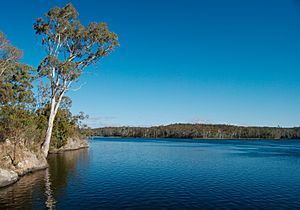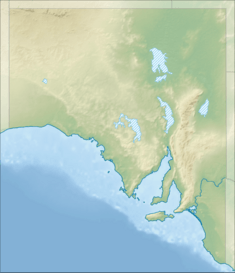Barossa Reservoir facts for kids
Quick facts for kids Barossa Reservoir |
|
|---|---|

The reservoir from its arch dam
|
|
|
Location of Barossa Reservoir in Australia South Australia
|
|
| Country | Australia |
| Location | Williamstown, South Australia |
| Coordinates | 34°39′00″S 138°50′56″E / 34.650°S 138.849°E |
| Purpose | water supply |
| Construction began | 1899 |
| Opening date | 1902 |
| Owner(s) | SA Water |
| Dam and spillways | |
| Type of dam | Arch dam |
| Impounds | Yettie Creek |
| Height | 36 metres (118 ft) |
| Length | 144 metres (472 ft) |
| Reservoir | |
| Total capacity | 4,515 megalitres (159.4×106 cu ft) |
| Surface area | 0.62 km2 (0.24 sq mi) |
| Website http://www.sawater.com.au/community-and-environment/our-water-and-sewerage-systems/water-sources/reservoir-data/barossa-reservoir |
|
The Barossa Reservoir is a large lake in South Australia, Australia. It was built a long time ago, between 1899 and 1902. Its main job is to hold water and supply it to towns like Gawler and other areas in the north.
When it was finished, the Barossa Reservoir was a very impressive project. The wall of the dam is 36 metres (118 ft) tall. At the time it was built, this made it the highest dam wall in all of Australia!
Contents
Amazing Design and Features
The Barossa Reservoir has a special design. Its dam wall is thin and curved, like an arch. This shape helps it hold back the huge amount of water. This design was quite new and clever for its time. It even got attention from engineers around the world! Magazines like Scientific American wrote about it.
The Whispering Wall
One of the most famous things about the Barossa Reservoir is its "Whispering Wall." This is because of a cool sound trick! If you stand at one end of the curved wall and whisper, someone at the other end (over 140 metres (460 ft) away) can hear you clearly! This amazing sound effect is caused by the wall's unique curved shape, which acts like a giant parabola and guides the sound. It's a popular spot for visitors and has earned the dam its nickname.
How the Reservoir Was Built
Building the Barossa Reservoir was a big job. Over 400 people worked to create it by blocking the Yettie Creek gorge. They used large stones to save concrete and even old tram rails to make the top part of the wall stronger.
The water for the reservoir comes from different places. A two-kilometre (one-mile) tunnel, dug by horses, brings water from the South Para River and Reservoir. Water also comes from the Warren Reservoir and the River Murray. In 1982, a special plant was built to clean the water. This means the reservoir can now supply water to more areas, including the suburbs of Munno Para and Elizabeth.
Nature Around the Dam
The area around the Barossa Reservoir is also protected and beautiful. Besides the Whispering Wall, you can enjoy great views of the reservoir and the natural surroundings. There are lots of trees like red gums and pines. You can also see many different birds and animals living there. It's a great place for picnics and watching birds.
In 2008, the dam's clever engineering was officially recognized by a group called Engineers Australia.
Quick Facts About the Dam
- Water Capacity: The reservoir can hold 4,515 megalitres (159.4×106 cu ft) of water.
- Wall Length: The dam wall is 144 metres (472 ft) long.
- Wall Height: The dam wall stands 36 metres (118 ft) tall.
- Deepest Point: The water is 28.6 metres (94 ft) deep at the wall.
- Wall Type: It's a concrete arch wall.
Gallery




